A Private Tour today in North Norfolk. It was a gloriously hot and sunny day. We had a list of potential target species to look for, an interesting mix of lingering winter visitors and scarce breeding birds.
Our first stop saw us looking for Nightingales. As soon as we got out of the car, we heard one singing. We walked round to the other side of the trees, but it had chosen a really dense clump of bushes to sing from today, so it quickly became clear we wouldn’t be able to see it unless it moved. We stood and listened to it for a few minutes, such a beautiful song, then decided to try looking for another one instead.
As we walked up the lane, there were lots of warblers singing in the hedgerows. A Willow Warbler perched high in the bare branches of a tree. A Cetti’s Warbler shouted at us from a hawthorn and we had a typical glimpse of it as it shot out and disappeared down into the ditch beyond. Several Blackcaps, Chiffchaffs and a Reed Warbler were all singing too.
When we got to the trees, we could just hear the other Nightingale singing. It has a spot which it favours where it is possible to see it, but it was much deeper into the wood today. It quickly went quiet so we stood and scanned the trees while we waited for it to start up again. A large Cockchafer flew around the bushes in front of us. When the Nightingale did start singing again, we could hear that it had moved and it seemed to be back in its favourite spot. Sure enough, there it was, perched in a tangle of dead branches and brambles, in the sunshine.
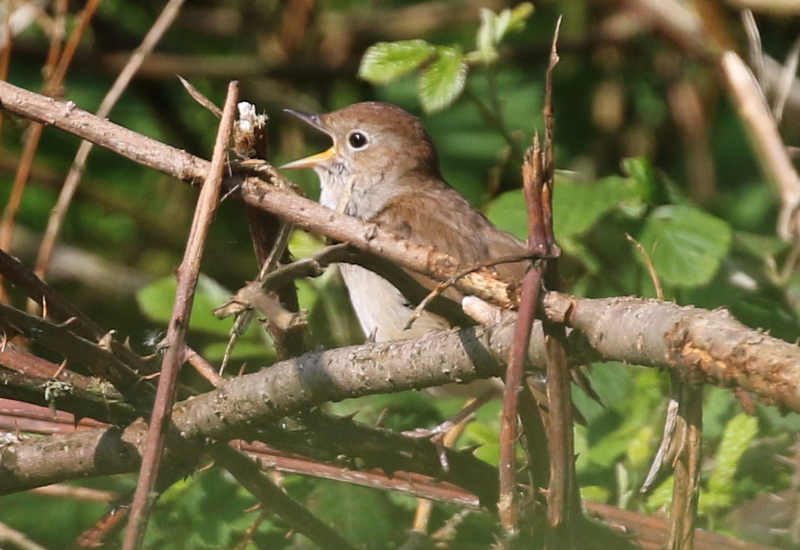 Nightingale – great views of this one singing today
Nightingale – great views of this one singing today
We watched the Nightingale for a while, as it perched singing or hopped between the branches. When it finally dropped down into the thicket out of view, we decided to move on. It had been a great way to start the morning.
One of the requests for the day was to try to find a Firecrest. They are patchily distributed in North Norfolk, and it is not the easiest time of year to look for one, but we thought we would give it a go anyway. We parked up on the Holt-Cromer ridge and set off to walk to an area where we know they are present.
As we made our way towards the trees, we passed through an area of fields. A Common Whitethroat was singing from the top of a hedge and we could hear a Yellowhammer calling quietly. A quick scan and we caught sight of its bright yellow head, a smart male perched in the bushes. A couple of partridges flushed from the edge of a field and landed in the open briefly, before scurrying into cover, just long enough for us to see they were Grey Partridges.
When we got to the edge of the trees, a Garden Warbler was singing but well hidden from view, as was a Goldcrest too in the tops of some pines. A Green Woodpecker laughed at us and we could hear a pair of Bullfinches calling plaintively, but the trees were too thick here to see anything.
We continued into the wood, to an area which we know the Firecrests favour. It was already getting quite warm now and it was fairly quiet deep in the trees. We walked up a ride flanked by firs and, when we got to the far end, we heard it – a brief snatch of song, a Firecrest. It sang twice more, just enough for us to get a rough fix on its location, and then went quiet. It seemed to be singing in a tall fir tree a short way into the wood, surrounded by deciduous trees. We scanned the bits we could see, but the Firecrest was probably in the top, which protruded above the canopy and into the sunshine.
As we stood and waited to see if it would sing again, we noticed a falcon circling behind the trees. It was a Hobby and as it drifted out into view we noticed that there was a second Hobby with it. We watched as they circled high overhead, before disappearing behind the trees again. A Common Buzzard drifted over too, and a little later, on our way back, we would see a Red Kite over the trees as well, all enjoying the rising thermals.
 Hobby – a pair circled high over the trees
Hobby – a pair circled high over the trees
The Firecrest sang another couple of times, and it was clear that it was moving about in the canopy, but it was still impossible to see it, looking up from below the trees. When it sounded like it had moved towards the firs bordering the ride, we went back out and scanned the trees from there, but there was still no sign of it. Then it went quiet and we decided to give up. It was good to hear it singing, but it would have been nice to see it.
As we walked back out of the wood, we came across a family of Treecreepers. A Goldcrest was collecting food and taking it back into a fir, where we presume it had a nest. A Jay flew across the path ahead of us. As we walked back to the car, we could see the two Hobbys still hawking for insects over the ridge.
Stock Dove was another target and as we got back to the car, we could hear one calling from the trees nearby. We were not going to be able to see it in there, but thankfully a second Stock Dove appeared on the wires next to the road, where we could get a good look at it through the scope. The two Stock Doves whooped to each other, before the one on the wires flew off towards the trees.
 Stock Dove – perched on the wires next to the car
Stock Dove – perched on the wires next to the car
We made our way round and up onto the Heath next. It was really starting to warm up now, but there were still a few Willow Warblers and Blackcaps singing in the trees. We flushed lots of Linnets from the gorse as we walked round, thankfully still a fairly common bird on the heaths although now much more scarce in its traditional farmland habitat. A Kestrel was hovering over an open clearing and as we looked over towards it, we could see a pair of Hobbys circling high beyond, perhaps the pair we had seen earlier working their way along the ridge.
 Linnet – still a common bird up on the heaths
Linnet – still a common bird up on the heaths
Dartford Warbler was one of our targets here, but all was quiet at the first spot we tried. We carried on round to another location where we know they are feeding young at the moment, which should give us a better chance to see them. On the way, we passed through an area where the Woodlarks like to feed, but there was no sign of them either. Someone else looking for them told us that a large group of people had been through here just a little earlier, so the birds had probably been disturbed.
At the next location for Dartford Warblers, it all seemed quiet too, at first. We stood and listened for a minute where they had been a couple of days ago, then decided to have a quiet walk round their territory. As we were walking along a narrow path, the male Dartford Warbler suddenly flew up in front of us singing, hovering in mid air for a second or two, before dropping back behind some tall gorse. We crept round the corner, and there it was, in the gorse just a couple of metres away from us. Stunning!
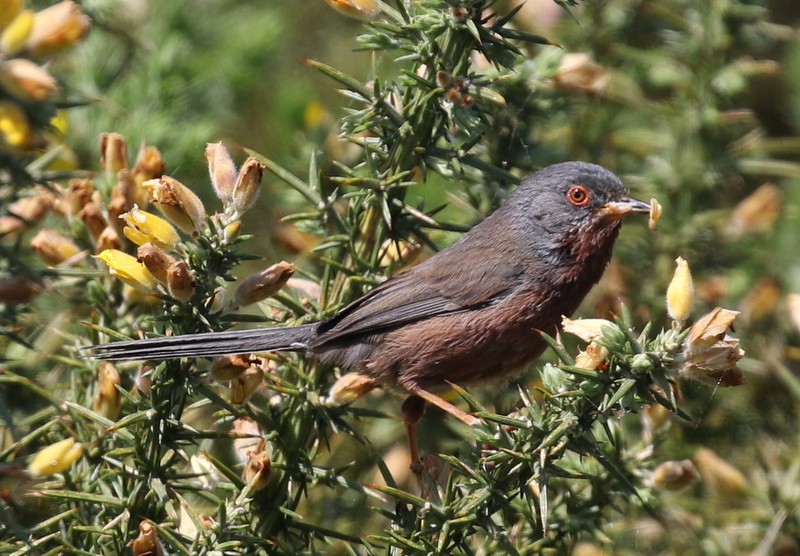 Dartford Warbler – the male, collecting food
Dartford Warbler – the male, collecting food
We followed the Dartford Warbler for a few minutes at a discrete distance, as it crept through the gorse, collecting caterpillars. We had some fantastic views of it. Occasionally, it would stop just long enough to deliver a short burst of song, before carrying on the hunt. Finally, when it had collected a bill full of food, it went zooming off over the heather, to deliver it to its hungry brood.
There is another area where the Woodlarks have been collecting food recently, but they weren’t there either. We thought they might be back at the first place we had looked, after a while left in peace, but we still couldn’t find them. We were just about to give up when we heard a Woodlark calling quietly. A careful scan, and we found it perched on a fence post a short distance away. We had a good look at it through the scope before it dropped down to the ground out of view.
It was time for lunch now, so we dropped back down to the coast and along to Cley, where we could sit out on the picnic tables and enjoy the fine weather. After lunch, we had a scan of the scrapes from the visitor centre, and looked at the sightings board, but there didn’t seem to be much on the reserve today, so we decided not to go out to the hides.
Bearded Tit was another target for the day, so we headed round to have a walk out along the East Bank to see if we could find one. A leucistic drake Common Pochard on one of the pools was a bit of an oddity – an interesting bird to see. There were a few Reed Warblers and Sedge Warblers singing from the reeds as we walked out, and a Reed Bunting or two as well, but no sound of any Bearded Tits at first. Despite the lack of wind, it was perhaps just too hot now, in the early afternoon.
There were more birds around the Serpentine and Pope’s Marsh. Several Lapwings and Avocets were down in the grass, a few Common Redshank were calling and displaying. A single Ringed Plover was feeding along the edge of the Serpentine.
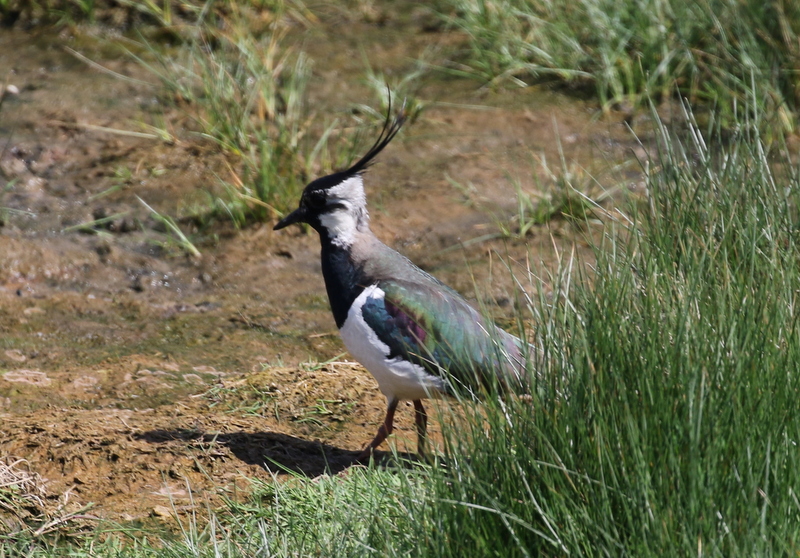 Lapwing – on the grazing marsh from East Bank
Lapwing – on the grazing marsh from East Bank
There were more ducks here too. Several drake Gadwall were chasing round after a female, pursuing her remorselessly all over the grazing marsh and out across the reedbed. As well as the regular Mallard and Shoveler, there were some late winter visitors too. A single drake Eurasian Teal and a lone Wigeon should probably both have been on their way north to breed already.
We were almost at the main drain when we finally heard a Bearded Tit calling. We stopped and listened for a while, and realised there were several birds here, in different places, though they were only calling occasionally. We had frustrating brief glimpses of a couple of birds zipping distantly over the tops of the reeds, which were hard to get onto, until a male Bearded Tit flew up from the reeds close to the near edge and flew off away from us, giving us a nice long flight view. It looked like that would have to do today, better than nothing.
There was a lot of heat haze looking out across Arnold’s Marsh this afternoon. We had heard a Little Tern calling as we walked out and could see one resting on the small island out towards the back. A party of Turnstones appeared on the island too, several in bright summer plumage, looking more appropriately like their full name, Ruddy Turnstone. Three Dunlin were with them, two with their summer black bellies. A careful scan round the edges revealed a single Grey Plover, still in its rather grey winter plumage.
We carried on out to the beach and took a look out to sea. It was very calm today, but there was some sea fret hanging distantly offshore, partly obscuring the wind turbines. There were a few terns offshore, flying back and forth, some carrying fish. Mostly they were Sandwich Terns, but a pair of Little Terns were fishing close inshore and a single Common Tern flew past. Looking further out, on the edge of the fog, we spotted a long line of black ducks flying past. They were Common Scoter and there must have been at least 80 of them. Presumably they were making their way back north for the breeding season.
There were a few butterflies out today in the sunshine – mostly Peacock, Red Admiral and the odd Small Tortoiseshell. We also saw a couple of Painted Ladys on our travels today and, out along the East Bank, our first Common Blue of the year. The numbers of dragonflies are finally increasing now too, in the warm weather, with Four-Spotted Chaser and Blue-tailed Damselfly along the East Bank today.
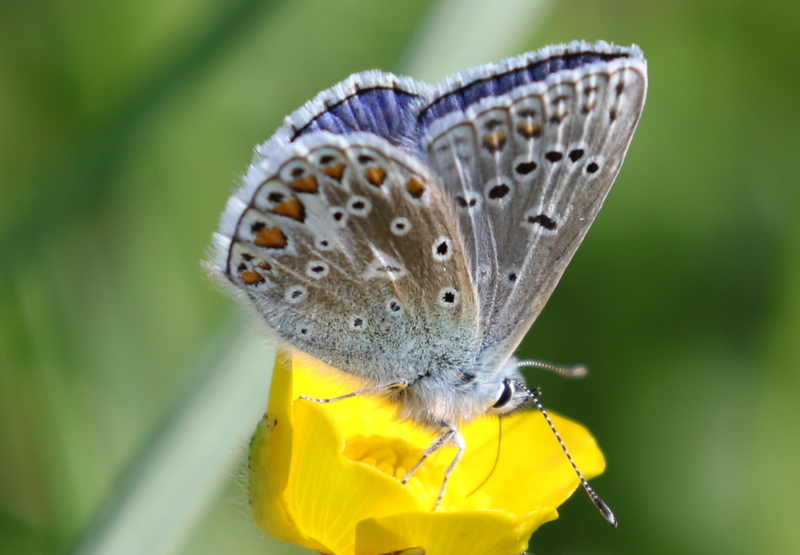 Common Blue – our first of the year, along the East Bank today
Common Blue – our first of the year, along the East Bank today
As we walked back along the East Bank, we bumped into one of the reserve volunteers who mentioned that he had seen a Bearded Tit along the edge of the ditch further back. So, as we made our way along, we scanned the bottom of the reeds and sure enough we found it, working its way along the edge of the water, in and out of the reeds. It was a female Bearded Tit.
When we quickly lost sight of it behind some taller reeds along the front edge of the ditch, we could hear another Bearded Tit calling and looked across to see it fly in and land down on the edge of the ditch just a few metres away. We walked back to look for that one, and just at that point it climbed up the reeds carrying something in its bill. It was a cracking male Bearded Tit, with powder blue head and distinctive black moustaches. It perched up in full view in front of us for several seconds, looking round, before flying off back over the reeds.
 Bearded Tit – this smart male was collecting food along the ditch
Bearded Tit – this smart male was collecting food along the ditch
It was great to get such a great view of a Bearded Tit, and a smart male to boot. Worthy reward for our perseverance! With that mission accomplished, we headed back to the car. There were still a few odds and ends on the target list, so we made thought we could squeeze in a quick couple more stops before the end of the day.
We drove back along the coast road to Kelling and had a quick walk down the lane to the Water Meadow. There were a few warblers singing in the hedges beside the lane, despite it being the middle of a hot and sunny afternoon – Chiffchaff, Blackcap and Common Whitethroat. We had hoped to find a Lesser Whitethroat along here, but there was no sign or sound of it here this afternoon.
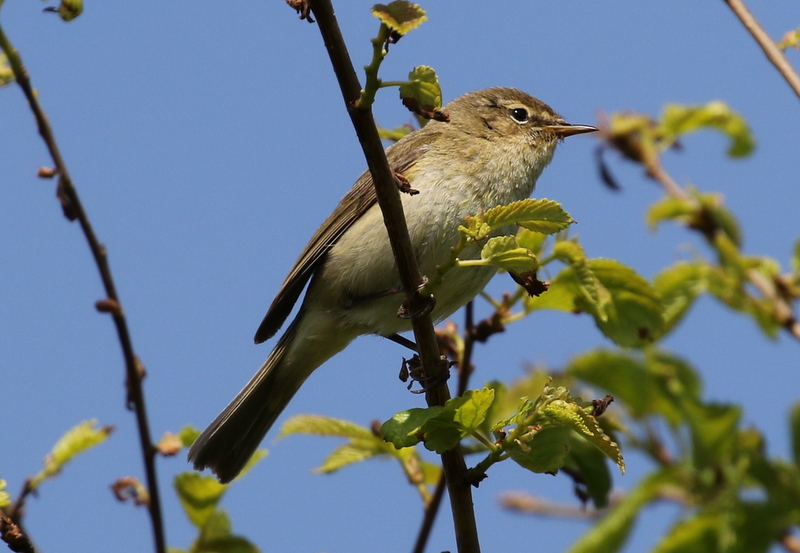 Chiffchaff – singing in the hedge along the lane this afternoon
Chiffchaff – singing in the hedge along the lane this afternoon
There were just the usual ducks on the Water Meadow, a pair of Gadwall, three Mallard and a lone drake Shoveler. One of the resident Egyptian Geese was guarding a gosling in the grass on the edge of the water. There were lots of Sand Martins hawking for insects over the pool. This is often a good spot for Yellow Wagtails in spring, but the grass is rather tall this year making them hard to see. As always, we had a careful scan around the feet of the cows and were duly rewarded with a pair of Yellow Wagtails flitting around the legs of one of them, before the cows moved back into the long grass.
Brent Geese are a common sight around the coast here in winter, but the vast majority of them have now departed on their way back to northern Russia for the breeding season. It is still possible to find the odd one or two with a bit of luck, so we decided to have a look in Blakeney Harbour to finish the day. As we made our way down the path towards Stiffkey Fen, a Lesser Whitethroat was singing in the bushes the other side of the road, but there was no way to see it from where we were and it seemed to be moving further back into the trees before it went quiet.
When we got up onto the seawall, the tide was already pretty high in the harbour. There was a big party of Oystercatchers gathered to roost out on the edge of the water, but we couldn’t see any Brent Geese where they have been recently. The Fen itself also looked pretty quiet today, with most of the winter waders having departed. There was a single Little Ringed Plover on one of the islands, plus three Common Redshanks which flew off from the edge of the reeds, and plenty of Avocets.
A Lesser Black-backed Gull in with the roosting Herring Gulls was a useful addition to the day’s list and a smart summer adult Common Gull was out on the water just beyond the reeds. A pair each of both Sandwich Tern and Common Tern flew in from the harbour and circled over the pool.
 Common Tern – a pair flew in from the harbour and circled over the Fen
Common Tern – a pair flew in from the harbour and circled over the Fen
A Cuckoo was singing in the trees beyond the Fen, but Brent Goose was our target here, so we focused our attention on trying to find one. Scanning carefully over the saltmarsh finally paid off when we located two Brent Geese feeding in the grass away to the west. Another one for the list and a perfect way to round off the day.
















